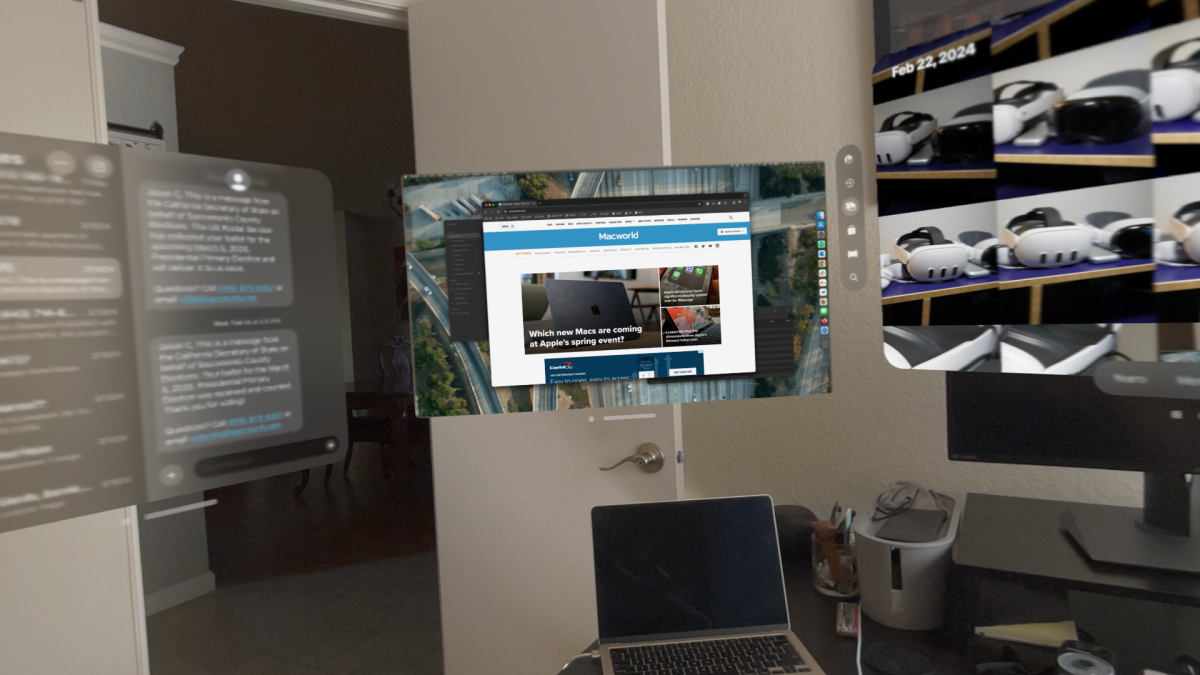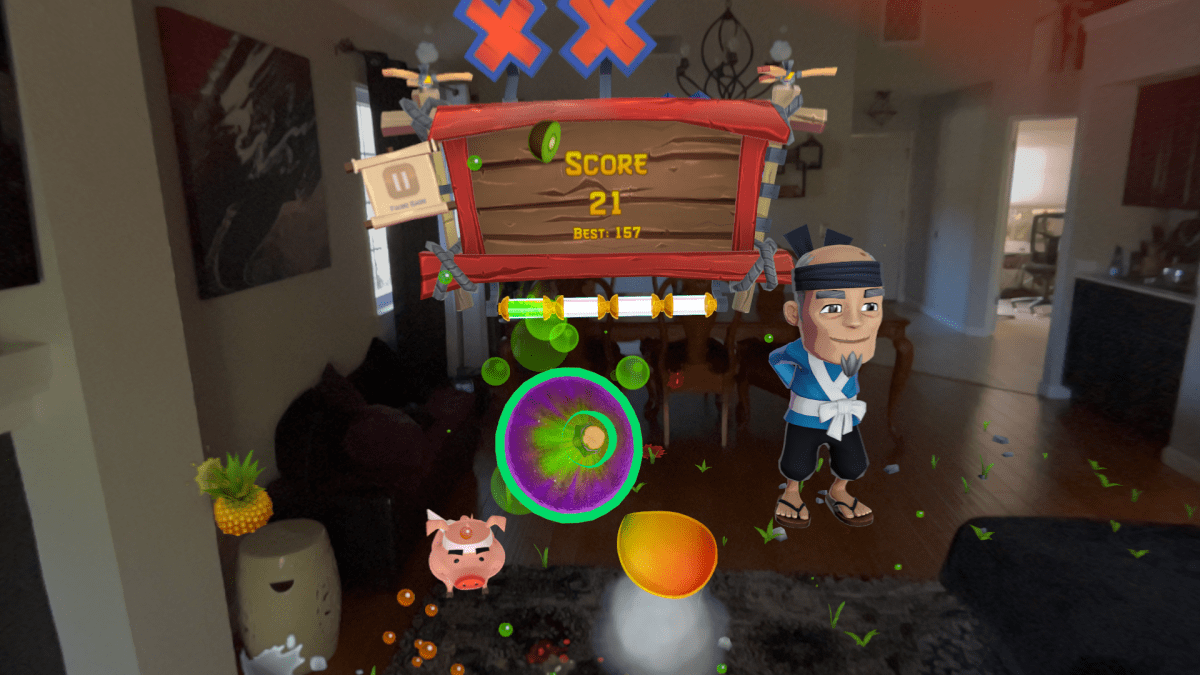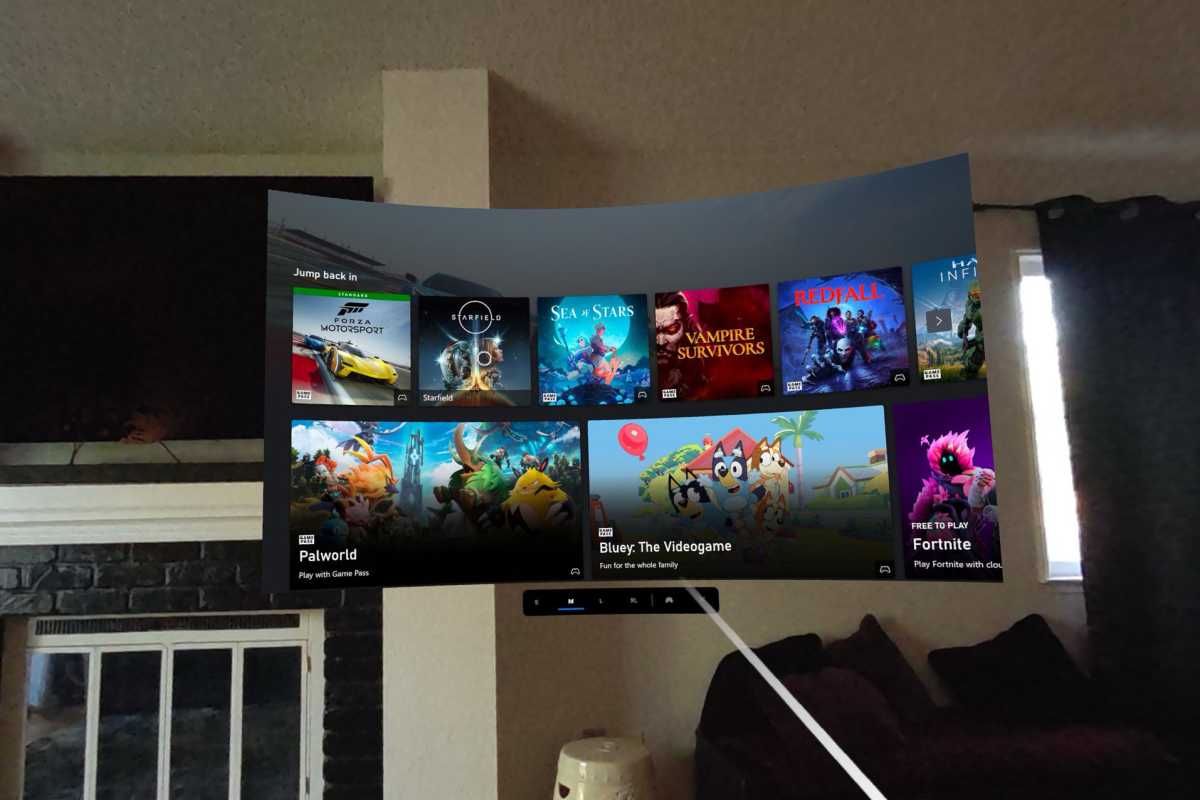Last week, Mark Zuckerberg took to Instagram and declared that, after trying Vision Pro, Quest 3 is “better for the vast majority of things that people use mixed reality for.”
Naturally, nobody should expect Zuck’s weird hotel hostage video to have glowing things to say about the competition’s headset. He’s CEO of Meta whose “Reality Labs” division is losing many billions of dollars a year on R&D, sales, and marketing of Quest headsets. His opinion on this matter is the least trustworthy, most conflicted a person could ever find.
But is he right? Does Quest 3 do for $500 what the Vision Pro can’t at 7 times the price? Is it a better overall product for “most people?”
After spending quite some time with both headsets, I think he has a point but is also missing some important things. He’s right, but not necessarily for the reason he thinks, and maybe not for long. Here’s how Quest 3 compares to Vision Pro right now, with the obvious caveat that this matchup will change over time as both products continue to evolve.
Let’s start with the obvious win for Quest 3: price. It starts at $500, while Vision Pro starts at $3,500. Obviously one is within reach for millions of potential customers and the other is a luxury item.
But it goes beyond the headset. The Quest 3’s accessories are all much more reasonably priced. The carrying case is $70, while Apple’s weird “wrinkled marshmallow” case is $199. An upgraded rigid strap is $70, Apple’s straps each cost $99 (though it comes with both).
Prescription lens inserts for Quest 3 are sold by Zenni and are $50, half the price of the Zeiss readers for Vision Pro and a third of the price of the prescription lenses. Many people won’t need them, however, as you can adjust the face gasket to be a little deeper and wear the Quest 3 right over most regular glasses.
While the Quest 3 also feels cheaper with its plastic construction and bigger seams and such, it’s the clear winner here. Vision Pro is just too far out of reach for too many people, no matter how good it is.
Winner: Meta Quest 3
Much has been said about the weight of the Vision Pro, which at 600-650g (depending on the strap) is about 20 percent heavier than the Quest 3. But it’s more than weight, it’s how sits on your head. The Quest 3 has a better strap and weight balance, and you can buy an Elite Strap for $70 that provides a nice rigid rear piece. As a result, the weight rests around and on the top of your head, and the headset itself barely has to press against your face—just enough to keep the light out.
Vision Pro carries almost all its weight way out front, and requires a lot of face pressure to keep it in place as you move around. Even with the Dual Loop band, which helpfully rests some of the weight on top of your head, there’s too much pressure necessary.
There’s more to comfort than the headset on your head, though. While Quest 3 wins that battle hands-down, Vision Pro is a more comfortable experience in other ways. For example, even though Quest 3 does hand tracking, the interface is unreliable without the controllers–its primary input method. Picking up controllers every time you want to do something is frustrating, especially if you’re trying to do some work with a virtual display and a keyboard.
I’m struck by how often the Quest 3’s fan spins up to a very audible level, too. You don’t notice it in a full VR experience with plenty of music and sound effects, but too many everyday activities are accompanied by a whrrr… backing track. I have never heard the Vision Pro’s fans, but teardowns reveal there are two of them.
What’s more, the Quest 3 pass-through video is very grainy and more distorted than Vision Pro. Apple does an incredible job un-distorting the video passthrough to match your natural vision’s perspective, which makes it more comfortable to look at for extended periods. For augmented reality stuff, it’s easier to look at the world for a long time through Vision Pro.
Quest 3 is still the more comfortable headset, thanks in part to Apple’s inferior bands and an over-reliance on metal and plastic, but it’s not as far ahead as you might think.
Winner: Meta Quest 3
This is an area where Vision Pro excels over Quest 3. Simply put, using a Vision Pro is easier. The interface, which relies entirely on eye and hand tracking, it cleaner and more intuitive. There are plenty of sore spots (you can’t make a window follow you, notifications need work, there are too many missing or under-cooked apps, the Home View stinks), but the simple act of manipulating your virtual environment is clean and clear.
Quest 3 is built around using controllers, and while controllers have a lot of value for some things, manipulating the core interface with what feels like a pair of laser pointers seems more like a “VR experiment” than a polished product. There are too many icons that are too small, it’s not clear how to resize things or when you can’t, and in augmented reality mode you’re limited to running three 2D apps at once. Apple does a better job with accessibility settings as well.

Foundry
The whole Quest interface feels fiddly and finicky, with a mishmash of ideas and conventions. Some things are icons, others are almost web-like “feeds.” Buttons are different sizes and shapes. Some interface targets are too small. Vision Pro’s interface may seem limited by comparison, but it’s clear and consistent and takes just a few minutes to learn. You can have a Quest 3 for days and you’ll still discover how things are supposed to work. I can’t imagine putting one on the face of someone who isn’t very technically savvy and asking them to figure out how to find, download, and launch a specific app.
Winner: Apple Vision Pro
If we’re being honest, neither headset is particularly adept at getting real work done. Both support virtual desktops, though Vision Pro makes it much easier to get connected to a Mac, and Universal Control makes it seamless to move your Mac’s keyboard and trackpad–but not mouse–between the Mac desktop and other Vision Pro apps. (With the right software, either headset will work with Macs and PCs).
The resolution and fidelity of the Vision Pro displays make it a more effective way to work with text on a virtual computer display than on Quest 3. But you’re just better off looking at a real monitor than working this way with either device.

Foundry
The apps made for the device itself aren’t really any better than anything you have on your laptop or desktop. They’re all limited in significant ways, as is your ability to access and work with files. The more open app environment of the Mac, and Finder, are far better for getting real work done.
The resolution and ability to easily run and reposition many flat applications make Vision Pro the winner here, and all the automatic cloud syncing of messages and photos and the like for those that use other Apple products really helps a lot. But you’re not going to get work done easier or faster with either device than you would with the headset off. Buying a second monitor is a bigger productivity boost for most people.
Thanks to better display fidelity, multitasking, and an easier and more intuitive controller-free interface, Vision Pro has the potential to be a much better productivity tool. The apps just aren’t there yet.
Winner: Apple Vision Pro
Right now, watching movies and videos is probably the most polished and mature use case for the Vision Pro. Whether flat, 3D, or spatial, the video-watching experience on Vision Pro is exceptional. Much of that is owed to the fantastic HDR displays, but the great spatial environments of apps like Disney+ help, too.
Gaming is another matter. Some iPad games are available, but unless you can play them with an Xbox or Playstation controller you’re never going to be able to control them. There are hardly any spatial games. Full VR games, especially big AAA titles, are all but nonexistent. And with no support for hand-tracking controllers, it’s hard to imagine how it’s going to ever be a great device for truly high-quality immersive games.

Foundry
Quest 3 doesn’t present video with as much fidelity as Vision Pro, but you have a lot more available. There are more streaming apps, you can view VR video on the web (Vision Pro can’t yet), and there are lots of apps that do a really good job of streaming VR or flat video from local network shares and the like. Apple’s headset is way, way behind on all of this.
Gaming is robust, with lots of quality VR games including big AAA titles. Asgard’s Wrath 2 is even bundled with all Quest 3 headsets right now, and puts any Vision Pro game to shame with its depth and quality. It’s also quite easy to play PC VR games from a Windows PC using wither a wireless connection or an affordable link cable. You can play Steam VR games or games on other PC marketplaces, and they make Vision Pro games look like silly toys.
Vision Pro offers a better video watching experience from its few supported apps, but lacks support for watching video any other way so the content selection is far too limiting. And the gaming situation is laughable.
Winner: Meta Quest 3

Foundry
If there’s a real sore spot with the Vision Pro, it’s the fact that it’s such a solitary device. Outside of FaceTime calls that put your Persona in a floating window (or a Zoom meeting or the like) there’s not really any way to do “spatial stuff” together with anyone else. You can’t really watch a movie together in the same virtual theater. You can’t have two people in the same room, both wearing Vision Pro headsets, looking at the same virtual object and interacting with it together. There are no online multiplayer games where you see the other person, or an avatar of them.
Contrast this with Meta’s approach, which prioritized multiplayer games from the early Oculus Rift days when the headset had to be tethered to a powerful gaming PC. Using Meta Quest 3 is full of multi-user experiences, from VR Chat to multiplayer games and of course Horizon Worlds, and the entire “metaverse” where people make avatars and walk around to play games, watch TV, and do all sorts of stuff together.

Meta
It’s unsurprising that a company whose main business is social media views connection and collaboration between users as a core principle, and Vision Pro was never going to launch with anything approaching a “metaverse.” Apple probably will never make one, and it’s too big a task for a third-party developer to have available this soon. But it’s deeply disappointing that so many of the core tasks with Vision Pro are entirely solitary. There’s a huge missed opportunity for telepresence in everything from working, watching TV or movies, watching sports, and of course gaming. Meta’s not just winning by default here, Apple’s sort of scoring an own goal.
Winner: Meta Quest 3
You’d think this is a slam dunk for Apple, since one sign-in and you’ve got all your Messages, Photos, Mail, and other stuff synced up nicely with your Mac or iPhone. Creating a Mac virtual display is as easy as glancing over at your MacBook and selecting the Connect button. And of course, there’s a decent library of Apple TV+ movies and shows filmed for Vision Pro with Apple Immersive Video.
But there are big gaps. It doesn’t actually work with your iPhone or Apple Watch–you can’t view your iPhone or iPad screen the way you can your Mac. You don’t get a notification when a call comes in. You can’t AirPlay video content from your other Apple devices into a VR screen in Vision Pro. Even when creating a virtual Mac display, the audio still comes from your Mac rather than the Vision Pro.
And there’s very little way to get it working with anything else. Third-party apps to let you play back video or audio files on your local network can’t seem to stream them. There’s no way to plug anything into the Vision Pro. You obviously can’t sideload apps, or install apps from the web or other marketplaces like you can on a Mac.

Foundry
The Quest 3 doesn’t have the holistic ecosystem of your photos and messages and such quickly and seamlessly available from the moment you log in. But it works with lots of things. You can plug in external storage, link to a PC, sideload apps, run VR games and apps from a Windows PC, and of course link up all sorts of controllers and bluetooth devices (far more than on Vision Pro).
While Vision Pro has a much easier ecosystem, it’s only with other Apple stuff and even that feels incomplete. Quest 3’s ecosystem is wide and plays pretty well with others, but often requires a lot of fiddling around to learn how to configure things or get them set up.
Winner: Meta Quest 3
Believe it or not, Zuck is right. He said the Quest 3 is better for the vast majority of things that people use mixed reality for. And it is.
Most people, globally, are not so deep into the Apple ecosystem where it’s the only thing that matters. They’re not going to benefit much from super simple cloud-synced Messages or Photos. They’re more likely to want to make a WhatsApp video call than FaceTime someone.
And currently, people mostly use mixed reality for entertainment and multiplayer, multi-user social experiences. Watching VR and flat video, playing games, and perhaps some home fitness stuff. The quality of watching video on Vision Pro is great but the selection is far too limited, and as a gaming or fitness device it’s a total non-starter.
What Zuck is missing, or at least choosing to ignore, is that he’s comparing the latest device in a years-long platform against the first device in a platform less than a month old. Part of the reason Quest 3 is good at “what people use mixed reality for” is because it has been the undisputed market leader for years. It’s self-fulfilling: Their headsets are great at doing what people use their headsets for.
Apple’s not about to catch up on value any time soon, and with no means of plugging anything into the Vision Pro the broader ecosystem prospects are limited. But with a few good software updates, some significant app updates, and new apps, Vision Pro can make big leaps forward. And there’s a real opportunity in creating new experiences that they don’t get on Quest headsets today.
Vision Pro’s chief problem is that it’s immature, not that it’s “closed” vs. the more “open” nature of Quest 3 that Zuckerberg touted. Apple is in a race to make big platform-level improvements, push major app updates, and drive developer interest faster than Meta can release software with a good interface and a headset with better displays and eye tracking.
If you were to buy a headset today, for doing what people use these headsets for now (entertainment, fitness, and socializing), the Quest 3 is definitely a better product. The superior productivity of Vision Pro doesn’t tip the scales, because frankly both devices are bad productivity tools in most situations. But for how long will Quest 3 remain the better headset? That’s up to Apple.

